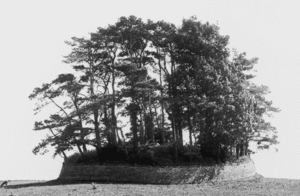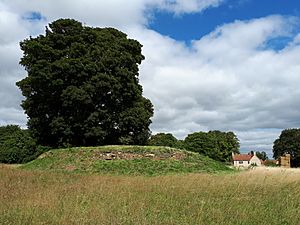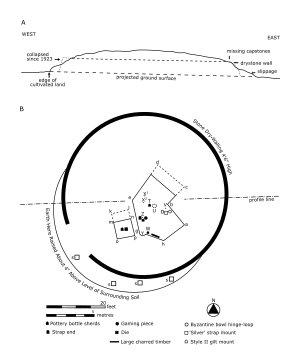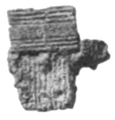Asthall barrow facts for kids
The Asthall barrow is an important Anglo-Saxon burial mound from the 600s AD. It is located in Asthall, Oxfordshire, England. Experts dug up and studied the mound in 1923 and 1924 to learn about its history.
Contents
Where is Asthall Barrow?
Asthall barrow is found near the A40 highway, between the towns of Witney and Burford. It sits right next to the A40 and is easy to spot. This ancient mound is also close to Akeman Street, which was a Roman road. This road used to cross the River Windrush, where a Roman settlement once stood.
The barrow offers amazing views of the Thames Valley. You can see for miles, from Lechlade to Wytham Hill. To the north, you can see Leafield barrow. To the south, Faringdon Hill and White Horse Hill are visible. Even Sinodun Hill and the Chilterns can be seen in the distance. The barrow is so famous that nearby places like Barrow Plantation and Barrow Farmhouse are named after it.
What Does Asthall Barrow Look Like?
Today, the barrow stands about 2.4 meters (about 8 feet) high. It is about 55 feet wide. In the past, it was even taller! Around 1907, it was recorded as 8 feet 6 inches high, and in 1923, it was 12 feet high.
A short dry stone wall, about 4 feet 6 inches tall, surrounds the barrow. This wall helps hold the mound in place. The barrow used to have many trees on top, like beeches and firs. These were probably planted in the 1800s. Now, only one large sycamore tree stands proudly on the mound. Other plants were removed in 2017 or 2018 to help preserve the site.
Scientists believe the barrow was built by gathering soil from the surrounding area. This is because Roman pottery pieces were found in the barrow's soil. The land around the barrow is used for farming, and in 1992, barley crops were growing right up to its edges.
What Was Found Inside the Barrow?
The Asthall barrow held many valuable items. These "grave goods" show that the person buried there was very important. Here are some of the things found:
- Pottery and Metal Vessels: There were at least seven containers. These included three pottery vessels, two handmade jars, a special bottle from the Merovingian period, and a small silver bowl or cup.
- Drinking Horn Pieces: Fragments of shiny foil were found. Five of these had cool animal patterns. This suggests that a decorated drinking horn was buried there.
- Gaming Set: Some items were made of bone. They were likely pieces from an ancient board game.
- Other Metal Items: Many copper alloy pieces were found. These included strap fittings, mounts, and rivets. Some were even gilded (covered in a thin layer of gold).
- Human and Animal Bones: Fragments of human bones were found, including finger bones and jaw pieces. There were also bones from a horse and a sheep. These were all cremated (burned).
All these amazing finds were given to the Ashmolean Museum. They help us understand more about Anglo-Saxon life and burial customs.
How Was the Barrow Explored?

The Asthall barrow was first dug up in August 1923. Another excavation happened in 1924. These digs were led by George Bowles, whose brother-in-law owned the land.
George Bowles had help from Tom Arnold and five other people. Edward Thurlow Leeds, an expert from the University of Oxford's Ashmolean Museum, also helped. Leeds gave advice, visited the site, and wrote about the main discoveries. He published his findings in a journal in 1924. He also talked about the 1924 dig in a book about Oxfordshire's history.
Bowles dug a large, uneven trench in 1923. In 1924, he added another trench and four smaller ones. He started by digging a deep, square hole. He found that the barrow had not been disturbed before. It was made of earth mixed with stones. He also found pieces of Roman pottery. The top layer of the barrow was covered in yellowish clay, possibly from the nearby River Windrush. On top of this clay, there was a lot of charcoal and ashes, showing that fires had been made there.
Protecting Asthall Barrow
Asthall barrow was officially made a "scheduled monument" on May 16, 1934. This means it is a very important historical site that is protected by law. Historic England, the group that manages these sites, says the barrow is "one of the best preserved examples" of its kind. They believe it still holds many secrets about its construction and the ancient landscape. The fact that part of its original stone wall is still there is very rare!
In 2009, the barrow was added to Historic England's "Heritage At Risk Register." This list helps identify and protect historical sites that are in danger. At first, the barrow was at risk because of too many trees and plants growing on it. Later, the main concern became rabbit burrows, which could damage the mound.
Thankfully, by 2016, the barrow's condition was improving. In 2018, it was removed from the "at-risk" list. This happened after trees and plants were removed, and work was done to keep rabbits away. The large sycamore tree on top was left alone. This important work was done with the help of the landowners and volunteers from the Cotswolds Area of Outstanding Natural Beauty.
Images for kids














